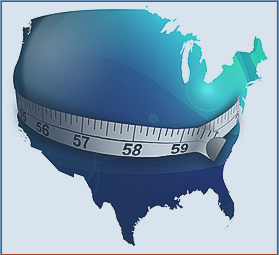obesity
The Obesity Pandemic
It’s a global phenomenon, with poorly understood causes. But there’s no point in blaming the victims.
I’ve written in the past about the American obesity epidemic. Obesity rates have continued to climb in the United States, though the rate of increase has leveled out. But obesity is also on the rise globally. The obesity rate has increased everywhere. In nine countries, at least one out of five people is now obese: …
Continue reading “The Obesity Pandemic”
CONTINUE READINGFood Policy: A Reply to Dan Farber
Earlier this week on this blog, Dan Farber made the excellent point that although the average American is neither malnourished nor obese, both persist as significant problems revealing deep failures in our food system. But his juxtaposition of statistics regarding obesity with those regarding malnourishment reflects a common misunderstanding of malnourishment, which is often equated with …
Continue reading “Food Policy: A Reply to Dan Farber”
CONTINUE READINGFood: Too Much and Too Little
Actual malnutrition among American children (weight more than two standard deviations below normal) is rare in the U.S. Most of the estimates that I found range around 1%. Still, there are roughly 45 million children under 12 in the U.S., so 1% amounts to almost half a million children. Malnutrition seems considerably more common among …
Continue reading “Food: Too Much and Too Little”
CONTINUE READINGThe State(s) of Obesity
There are big differences between states, but this really is a national epidemic.
State of Obesity, a joint project of the Trust for America’s Future and the Robert Wood Johnson Foundation, has released a fascinating report about adult obesity. There are large national disparities. The obesity rate is over 35% in West Virginia and Mississippi, but only 21% in Colorado. Despite these disparities, obesity rates have grown everywhere since 1990, …
Continue reading “The State(s) of Obesity”
CONTINUE READINGJeudi Gras – The Great American Holiday
Jeudi Gras means”Fat Thursday” in English. It would probably be a better name for the holiday than the current one. Let’s face it: for most of us, the day involves a bit of giving thanks and a much larger amount of pigging out like there’s no tomorrow. As the NY Times points out, this wouldn’t be …
Continue reading “Jeudi Gras – The Great American Holiday”
CONTINUE READINGThe American Way of Eating
Gallup has done a fascinating series of surveys recently on fast food and diet. Here are some highlights: What we eat? About 30% of Americans have fast food at least once a week, while another 30% say they have it once or twice a month. Interestingly, about half of Americans think fast food isn’t really …
Continue reading “The American Way of Eating”
CONTINUE READINGThe Emergence of Food Law
As with most holidays, Memorial Day is associated with a traditional food component — in this case, picnics. So this seems like a good occasion to talk about the emerging legal field of food law. According to the Food and Drug Law Institute, about sixty law schools have courses on Food and Drug Law, a …
Continue reading “The Emergence of Food Law”
CONTINUE READINGWhy I’m Boycotting Coke
Why Coke, you might wonder. Why not Pepsi? The answer is that diet coke is my soft drink of choice. It’s easy for me to boycott other soft drinks since I don’t drink them anyway. I like diet coke, so that’s the subject of my boycott. But why boycott soft drinks at all? Answer: Because …
Continue reading “Why I’m Boycotting Coke”
CONTINUE READINGThe NAACP and the Politics of Race and Regulation
There’s a bit of a kerfuffle going on about the NAACP’s defense of over-sized soft-drinks. In an amicus brief challenging New York City’s new ban on the super-size, the NAACP (joined by the Hispanic Federation and an association of Korean grocers) takes a surprisingly libertarian stance against government regulation. It laments that the ban is …
Continue reading “The NAACP and the Politics of Race and Regulation”
CONTINUE READINGSupersized Drinks, Social Welfare, and Liberty
Obesity is an environmental issue because the food system (from farm to table) uses a lot of energy and produces significant water pollution. More food equals a bigger environmental footprint. Sweetened soft drinks are a good example: they use corn sweetener, and corn production has a large footprint because so much fertilizer is required. There …
Continue reading “Supersized Drinks, Social Welfare, and Liberty”
CONTINUE READING





